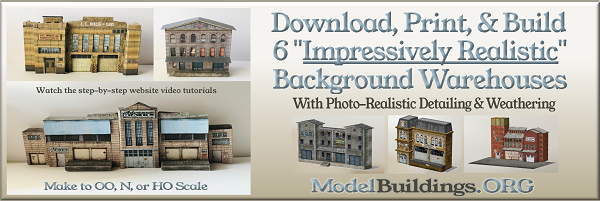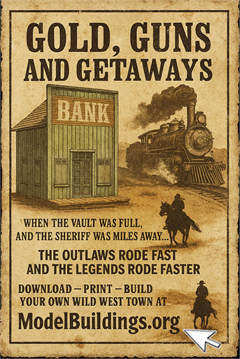Everything on model trains, model railroads, model railways, locomotives, model train layouts, scenery, wiring, DCC and more. Enjoy the world's best hobby... model railroading!
HO Track Separation
Online Model Train Club Member Ben submitted this query:
“I have limited space so want my opposing tracks close enough not to waste space, but far enough apart not to cause collisions or look fake. How far apart should I make them?”
Add your comments (or view all comments) using the COMMENTS link. Submit a question using the ASK A QUESTION link. Easy!
11 Responses to HO Track Separation
Leave a Reply















2” on center of both tracks, but if going on a curve add a 1” to be safe in order for longer cars to take the curve without hitting other cars on the opposit track. 3” total on a curve.
The gap will always commensurate with scale of track. I.e. N, HO and so on One I know the scale, it will be appropriate to suggest for the gap to be set.
Use of a HO Scale NMRA Standards Gauge is receommended. The track will always look nice. Using the dock clearance part of the gauge and adding 1/2″ spacing will put center-to-center track spacing at about 2-1/4″. Works well on tight radius curves. Note that longer cars do not work well with tight radius curves.
2.25″ on straight and you are ok. However, on curves you should increase the distance. sharper the curve the greater the distance. I have a 30″ min. in my layout with 2″ distance between tracks.
I do not have a permanent layout but set up different temporary designs from time to time. As my track is not fixed, it tends to move slightly out of shape when used. To make sure the spacing is correct, I use a set of parallel track tools. These are inexpensive (about £5 for a set of 4 in UK); I bought a set 5 years ago and I now have 3 sets – 2 twin track; 1 triple track. Mine are OO but I believe they are available in HO and N. So simple, but so effective. My longest carriages happily pass each other without collision!
run a coach around the curve with a pencil at the centre point on the side adjacent the other track. mark a line on the board following the coach centre route then make sure the other track clears the pencil mark, this will give you clearance and avoid collisions
Guys, in Britain and Aus the distance between the two tracks in real life is called the 6 foot, To replicate this exactly in model form doesn’t really account for full sized fingers so the NRMA 2.25 inch space on straight track is a good compromise. Harry’s discussion regarding curved track is apt, and i would go one further and place a pencil at the rear corner of my longest piece of rolling stock and draw the opposing curve on the other track, moving it out until my pencil lines cease crossing each other. The you can be sure opposing movements will not “kiss” or worse.
Hi Ben a limited space layout is what you have planned so use the usual distance between the paralell straight sections to 2″ centre to center then find your longest coach or wagon and test the overhang on what ever radius looks right and open up the gap so trains comming opposite way dont touch REMEMBER ONE COACH WILL HANG OUT THE OTHER WAY IT WILL CUT THE CORNER SO TRIAL AND ERROR IS ESSENTIAL FOR LOOKS may I suggest you use flexitrack as opposed to fixed radius track in ,my view its easier to work with cheers
You really need to work out how far apart your tracks need to be so your trains don’t hit. It varies with everyone’s curves and stock as well as scales and gauges. About 42mm is right for UK H0 gauge. 16.5 for the track gauge 24mm for theb 6 foot gap between tracks and 1mm for the rail head. This is too tight for wider US stock. peco use 52mm or 2″ which works down to about 2ft radius in H0 and UK 00, Peco Set Track is about 60mm which works down to around 13″ where it started with Triang back in the 1950s. I like to get the spacing as close as possible around the 44mm range on 00/H0 straights and use my loco with the biggest overhang on the inside and coach with the greatest overhang on the inside and adjust the second track so they just clear as I lay my track. A Hornby King 4-6-0 and a 64ft coach is my design combination, and I accept I can’t run 75 foot coaches on the outside and a King on the inside on my sharpest curve. i44mm means chopping a bit off points (switches) but that makes the points shorter which is itself is an advantage.
in the UK tracks are spaced with 6ft between pairs of tracks and then 10 feet to the next track or pair, Sometimes 6+10+6 sometimes 10+6+10, siding pairs are often less than 6ft apart with a much wider space so you can get a wagon in between pairs.
The NMRA has a track gauge. Set up parallel track in a curged pattern. Place a scribe or pencil on the outside corner of the car on inner radius. Note mark. Place long car on the inside middle on the car and repeat. Note mark. The marking should not cross or touch the other. Do same for large, long engines with a wide swing pilot such as cab forwards, etc. You will have your limits defined immediately.
Proto RR’s used 13′ widths for a hundred years. Now that cars are longer than 40′, the more modern yards are using 15-16′. 2″ in HO is 14.5′. So, that sounds like the best for straight track yards. Just barely enough to get you fingers on both sides of a car. And that’s probably the most commonly used on model RR. A little wider on curves for the reasons already mentioned. But that can depend on the longest cars you have. An 85′ car may require 3″ on curves. So, you will have to experiment a bit. If it helps, I like foam and I use caulk that makes it easier to pry back up to move the track over a bit. Hope this helps and isn’t too late.